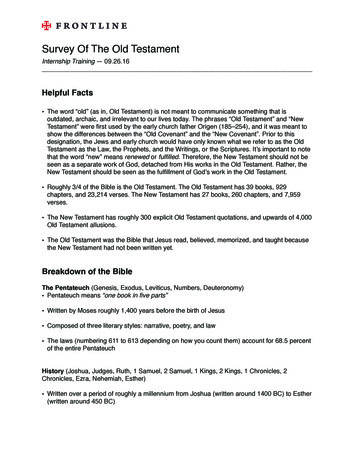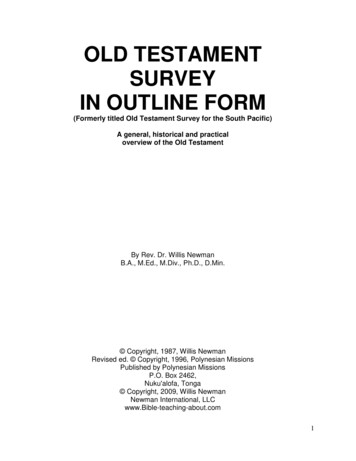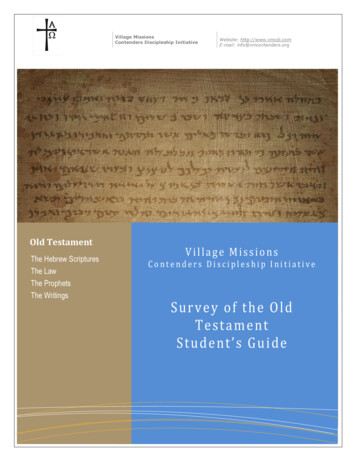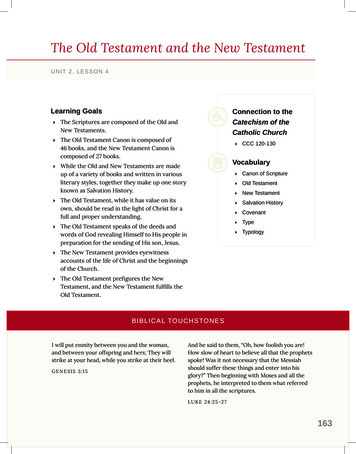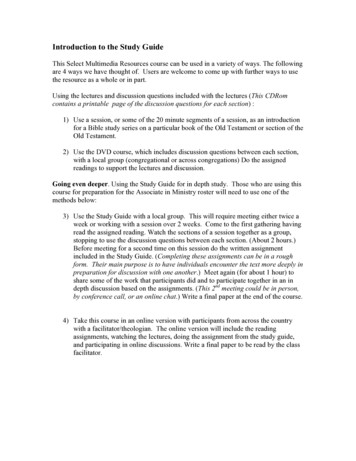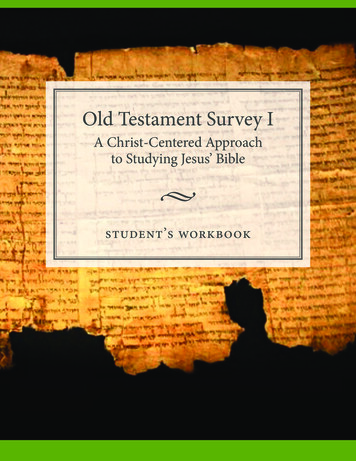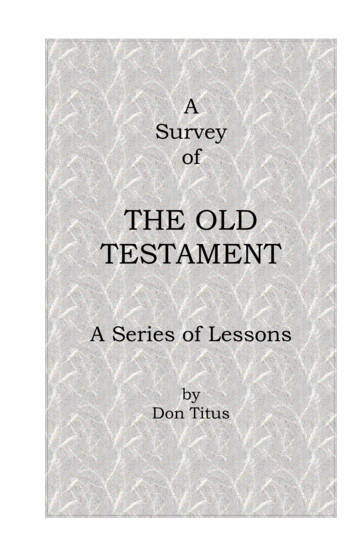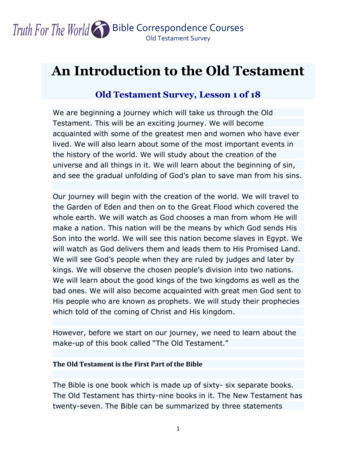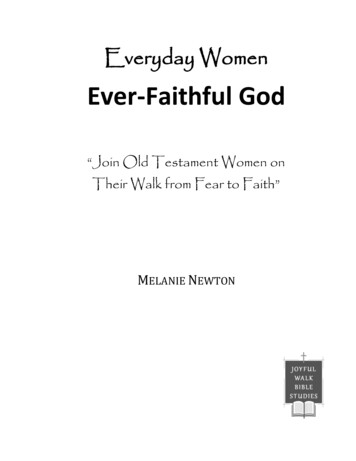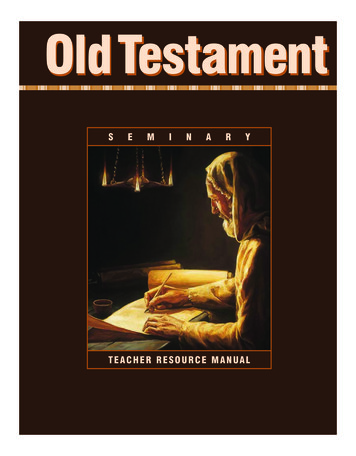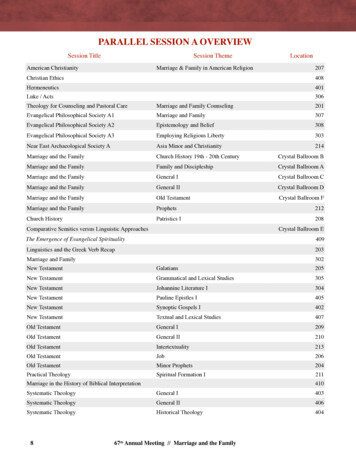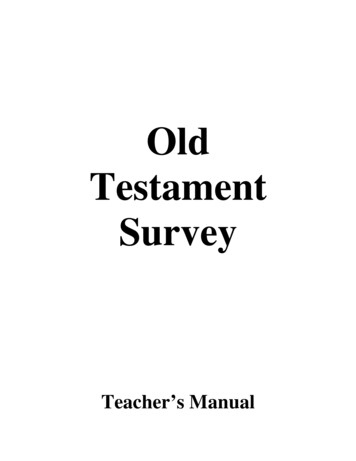
Transcription
OldTestamentSurveyTeacher’s Manual
Old Testament SurveyContentsLesson 1 – Why Study the Old Testament?.3-6Lesson 2 – Introduction to the Old Testament .9-11Lesson 3-4 – Genesis .12-18Lesson 5 – Exodus .19-22Lesson 6 – Leviticus, Numbers, Deuteronomy .23-30Lesson 7 – Joshua .31-36Lesson 8 – Judges .37-41Lesson 9 – Ruth . 42-45Lesson 10 – I & II Samuel . 46-51Lesson 11-12 – Kings and Chronicles .52-63Lesson 13-14 – Ezra, Nehemiah, Esther . .64-70Lesson 15-16 – Wisdom Literature . .71-87Lesson 17 – Isaiah . .88-94Lesson 18 – Jeremiah, Lamentations .95-100Lesson 19 – Ezekiel .101-105Lesson 20 – Daniel .106-110Lesson 21-22 – Minor Prophets, Hosea-Micah . 111-123Lesson 23-24 – Minor Prophets, Nahum-Malachi 124-137Old Testament Survey, Bill ScheidlerTeacher’s Manual2
Lesson 1Why Study the Old Testament?A. IntroductionFor many people the Old Testament of the Holy Bible is cloaked in mystery. Whenpeople become Christians, they are encouraged to read the Bible, but they are often directedexclusively to the New Testament and, perhaps, the Psalms of the Old Testament. There areeven versions of the Bible that only contain the New Testament and the Psalms.Many Christians spend their whole life reading primarily the New Testament books.If they do start reading in the Old Testament, they usually only make it through the first fewbooks of the Pentateuch before getting frustrated and jumping back to the New Testament.Part of the difficulty is that very few people understand the link between the Old andthe New Testament and do not see them as one book. In our normal course of life, no onesits down to read a book by starting in the middle and reading to the end. If this were done,so much would be lost in the sense of the book. In fact, one would run the risk of missing thewhole point of the book.It is no different with the Bible, the most unique book in the entire world. Eventhough it is comprised of 66 books, written by multiple human authors over a period ofnearly 2000 years, it is one book and can only be truly understood and appreciated when seenin that light.B. Why Study the Old Testament?1. Because it is part of the “All Scripture” that is given by inspiration of God that isprofitable for doctrine, for reproof, for correction and for instruction in righteousness(II Tim. 3:14-17).“But you must continue in the things which you have learned and been assured of,knowing from whom you have learned them, and that from childhood you have knownthe Holy Scriptures, which are able to make you wise for salvation through faithwhich is in Christ Jesus. All Scripture is given by inspiration of God, and isprofitable for doctrine, for reproof, for correction, for instruction in righteousness,that the man of God may be complete, thoroughly equipped for every good work.”a. The Scripture of the Old Testament provides a source of wisdom.b. The Scripture of the Old Testament leads us to salvation.c. The Scripture of the Old Testament guides our steps.d. The Scripture of the Old Testament equips us to fulfill our destiny.2. Because “whatever things were written before were written for our learning, that wethrough the patience and comfort of the Scriptures might have hope” (Rom. 15:4; IPet. 2:12-13).“Of this salvation the prophets have inquired and searched carefully, who prophesiedof the grace that would come to you, searching what, or what manner of time, theSpirit of Christ who was in them was indicating when He testified beforehand thesufferings of Christ and the glories that would follow. To them it was revealed that,Old Testament Survey, Bill ScheidlerTeacher’s Manual3
not to themselves, but to us they were ministering the things which now have beenreported to you through those who have preached the gospel to you by the Holy Spiritsent from heaven—things which angels desire to look into.” I Peter 1:12-13a. The Scripture of the Old Testament was written for our learning.b. The Scripture of the Old Testament was written specifically for us in the ChurchAge not simply those who lived in Old Testament times.c. The Scripture of the Old Testament was written to bring comfort to us as we walkin faith in the New Testament Age.3. Because “all these things happened to them as examples, and they “were written forour admonition, on whom the ends of the ages have come” (I Cor. 10:6, 11).a. The Scripture of the Old Testament gives us examples of both the positive and thenegative to bring admonition to our lives.b. The Scripture of the Old Testament is especially written for the last generationbefore the return of Christ to inspire the faith needed to fulfill the uniquechallenges of that era.4. Because the whole Old Testament was a shadow of the real (Heb. 10:1). It is thepurpose of the shadow to point us to the real or the substance that has come to us inChrist (Col. 2:16-17; Heb. 8:5).So let no one judge you in food or in drink, or regarding a festival or a new moon orsabbaths, which are a shadow of things to come, but the substance is of Christ.Colossians 2:16-17a. The Scripture of the Old Testament gives us tangible or visible expressions ofinvisible realities.b. The Scripture of the Old Testament points us to and help us to visualize all thatwe have been given in Christ.Old Testament or CovenantNaturalFleshTestimonyShadowFigureMade with HandsPatternsFiguresFor a TimeVisible (Seen)TemporalBy SightOld Testament Survey, Bill ScheidlerTeacher’s Manual4New Testament or CovenantSpiritualSpiritThings Spoken AfterImageThings to ComeNot Made with HandsHeavenly ThingsTrueEternalInvisible (Unseen)EternalBy Faith
Study the chart above in relation these verses: John 3:5-6; II Corinthians 4:18;Hebrews 3:5; 8:7, 13; 9:9, 23-24; 10:9.c. The Scripture of the Old Testament presents the natural that precedes and pavesthe way for the spiritual (I Cor. 15:44-47).However, the spiritual is not first, but the natural, and afterward the spiritual.I Corinthians 15:46 Natural birth precedes spiritual birth (Jn. 3:5). Natural Israel precedes spiritual Israel (Gal. 6:16). Natural Jerusalem precedes spiritual or heavenly Jerusalem (Heb. 12:22). Natural temple precedes the spiritual temple (I Pet. 2:5). Natural priesthood precedes a spiritual priesthood (I Pet. 2:5). Natural sacrifices precede spiritual sacrifices (Heb. 13:16). Natural enemies and warfare precede spiritual enemies and warfare (Eph.6:12).5. Because the entire Bible, including the Old Testament is the story of Jesus Christ ourRedeemer (Mt. 5:17; Lk. 24:27, 44; Jn. 1:45; 5:39, 46-47; Acts 10:43; Gal. 3:24; Heb.10:7).“You study the Scriptures, because you think that in them you will find eternal life.And these very Scriptures speak about me!” --Good News TranslationThen He said to them, “O foolish ones, and slow of heart to believe in all that theprophets have spoken! Ought not the Christ to have suffered these things and to enterinto His glory?” And beginning at Moses and all the Prophets, He expounded to themin all the Scriptures the things concerning Himself. Luke 24:25-27a. The entire Bible, both Old and New Testaments, is His—Story (History). He isthe unifying theme of the whole Bible.b. The entire Bible, both Old and New Testaments, is an unfolding of the plan ofredemption. The first two chapters of Genesis and the last two chapters ofRevelation are history before sin and after sin with everything in betweencovering the redemption of man.c. The entire Bible, both Old and New Testaments, relates the unfolding strugglebetween the two seeds—the seed of the serpent and the seed of the woman (Gen.3:15).The Seed of the WomanChildren of LightThe Seed of the SerpentChildren of DarknessMystery of GodlinessMystery of IniquitySpirit of TruthSpirit of ErrorOld Testament Survey, Bill ScheidlerTeacher’s Manual5
Children of PromiseChildren of the FleshKingdom of GodKingdom of SatanLifeDeathGodly Seed or LineGodly Seed or LineChristAntichristd. The entire Bible, both Old and New Testaments, could be labeled the Book of theRevelation of Jesus Christ.6. Because the Old Testament is the foundation on which the house of the NewTestament is built (Heb. 3:1-6; Eph. 2:20).Now, therefore, you are no longer strangers and foreigners, but fellow citizens withthe saints and members of the household of God, 20 having been built on thefoundation of the apostles and prophets, Jesus Christ Himself being the chiefcornerstone, 21 in whom the whole building, being fitted together, grows into a holytemple in the Lord, 22 in whom you also are being built together for a dwelling placeof God in the Spirit. Ephesians 2:19-22a. God has only ever had one people—His chosen ones. The saints of the NewTestament are inseparably connected to the saints of the Old Testament (Heb.11:40; Mt. 8:11).b. The prophets of the Old Testament and the apostles of the New Testament wereall working on the same spiritual temple made of both Jew and Gentile (Eph.2:19-22).7. Because the first church was build upon the revealed Scriptures of the Old Testament(Acts 6:2-7; 18:11; 28:23).“Now the Bereans were of more noble character than the Thessalonians, for theyreceived the message with great eagerness and examined the Scriptures every day tosee if what Paul said was true.” Acts 17:11, NIVa. The Scripture of the Old Testament is the only word that shaped the NewTestament church because it was the only Bible they had.b. Rightly dividing the Scripture of the Old Testament was essential for the successof the Early Church (II Tim. 2:15). Without adherence to the principles containedin the Old Testament, the New Testament workman will end up being “ashamed.”“Do your best to present yourself to God as one approved, a workman who doesnot need to be ashamed and who correctly handles the word of truth.” (NIV)Old Testament Survey, Bill ScheidlerTeacher’s Manual6
Lesson 2Introduction to the Old TestamentA. Background of the Old TestamentThe term “Old Testament” is most commonly used to apply to what is known as theHebrew Bible consisting of 39 individual books, covering the time from the creation ofthe world to approximately 400 years prior to the birth of Jesus Christ.1. AuthorshipWhile there is some debate about the authorship of some of the books, it is generallyaccepted that over thirty writers over a period of approximately 1200 yearscontributed to the content of the Old Testament as we know it today.2. LanguageMost of the Old Testament was written originally in Hebrew. A few minor portionsin books like Ezra, Daniel and Jeremiah seem to have been written in Aramaic, a nearlanguage to that of Hebrew and very likely the language which Jesus spoke in theNew Testament era.The Old Testament was translated into Greek somewhere in the middle of the thirdcentury B.C. The Greek translation of the Hebrew Old Testament is known as theSeptuagint (in reference to some 70 Jewish elders who worked on the translation).This version was in common use during the time of Jesus especially among the Jewsof the dispersion.3. CultureThe Old Testament comes to us out of a very different culture to that of the modernwestern experience and, therefore, can only be understood fully by understandingcertain elements of early eastern culture. The culture of the Bible is a shepherdingand agricultural culture. Most of the marriage customs of the Bible times are verydifferent to our western understanding of things.B. Division of the Books of the Old Testament1. The Old Testament is categorized in the New Testament in various ways including: The Law and the Prophets (Mt. 7:12; 11:13; 22:40; Lk. 16:16)Moses and the Prophets (Lk. 16:29-31)The Law, the Prophets and the Psalms (Lk. 24:44).44Then He said to them, “These are the words which I spoke to you while I was stillwith you, that all things must be fulfilled which were written in the Law of Moses andthe Prophets and the Psalms concerning Me.” Luke 24:44Old Testament Survey, Bill ScheidlerTeacher’s Manual7
2. The more common way of looking at them for the purpose of study is to divide thebooks into five sections including The Pentateuch, Historical Books, Poetical Books,The Major Prophets and The Minor Prophets (See Chart on page 10).C. Approximate Chronology of the Old TestamentThe books of the Old Testament are not arranged in chronological order. They arearranged by category as listed above. When reading any of the books, especially theprophets, it is important to tie them together with the historical books of the same era.The following timeline will serve as a guide for the student of the Old Testament (SeeChart on page 11).D. Outline of History Covered in the Old TestamentEvent(s)LocationHistorical BooksCreationGarden of EdenGenesisFall of ManGarden of EdenGenesisMan Expelled from GardenMesopotamiaGenesisPopulating of the EarthWidespreadGenesisFlood of NoahWorldwideGenesisCall of AbrahamChaldeaGenesisPatriarchs—Abraham, Isaac,Jacob, Twelve SonsMesopotamia (Nomadic)GenesisJoseph, Israel to EgyptEgyptGenesisIsrael in BondageEgyptExodusIsrael in WildernessSinai Peninsula (Nomadic)Exodus-DeuteronomyIsrael under JoshuaCanaan/PalestineJoshuaIsrael under JudgesCanaan/PalestineJudges, RuthIsrael United under Kings,Saul, David, SolomonCanaan/PalestineI & II Samuel, I Kings, IChroniclesIsrael Divided, Northern,SouthernCanaan/PalestineI & II Kings,I & II ChroniclesNorthern Kingdom Captive toAssyria (10 Tribes)AssyriaII Kings,II ChroniclesSouthern Kingdom Captive toBabylon (3 Tribes)BabylonII Kings, II ChroniclesRestoration of Judah to LandCanaan/PalestineEzra, Nehemiah, EstherE. Ways to Study the Old Testament1. ChronologicallyOld Testament Survey, Bill ScheidlerTeacher’s Manual8
In this format of study the books of the Old Testament are arranged in chronologicalorder and studied in regards to their historical settings and the local prophetic context.2. CovenantallyIn this format of study the Old Testament is looked at in relation to God’s ninecovenants with man culminating in the New Covenant laid out for us in the NewTestament.3. MessianicallyIn this format of study the each book of the Old Testament is seen as a uniquerevelation of the Messiah who was to come. Each book is highlighted with regard tohow Christ is seen in that book.F. The Relationship of the Old Testament to the New TestamentBoth the Old and New Testaments are parts of one book or one divine revelation.Genesis 1-2 gives us the creation of man apart from sin, Revelation 21-22 gives us thestate of things after sin and everything in between is the unfolding of God’s plan ofredemption for man. It has been stated this way:The New is in the Old concealed;The Old is in the New revealed.The New is in the Old contained;The Old is in the New explained.The New is in the Old enfolded;The Old is in the New unfolded.G. Our Approach to the Old TestamentIn this course we will survey of all the Old Testament books, emphasizing their historicsetting and thematic content. Each book will be highlighted for its relationship to Christand to its special contribution to the rest of Scripture.Old Testament Survey, Bill ScheidlerTeacher’s Manual9
Old Testament Survey, Bill ScheidlerTeacher’s Manual10
Old Testament Survey, Bill ScheidlerTeacher’s Manual11
Lesson 3-4Genesis—The Book of BeginningsA. What is the significance of the name “Genesis?”1. The word “Genesis” means “beginning, origin or birth”.2. Genesis is the Book of Beginnings.a. The Book of Genesis marks the beginning of the universe. It lets us know that theuniverse had an actual beginning, that matter is not eternal and that God was theactive force in creation.b. The Book of Genesis details three new beginnings.1) The original creation (Gen. 1-9) that was followed by the fall of mankind,rebellion and ultimately God’s judgment in a worldwide flood.2) The new beginning with Noah and his family that was followed by the towerof Babel rebellion and ultimately God’s judgment in the confounding oflanguages (Gen. 10-11).3) The new beginning with Abram (Gen. 12-50) when God put His hand on anation and set them apart as His instrument in the earth to fulfill His purposes.c. Key words in the Book of Genesis include: Begat (67), Generation (21) and someform of begin or beginning (12).3. Genesis is the Seed Plot of the Bible.Themes that begin in Genesis are developed in the rest of the Bible only to end up inthe Book of Revelation. Note the following:a. The Seed of the Woman becomes Christ and His Church (Rev. 12:17).b. The garden or paradise of God gives way to the foursquare city of God, the NewJerusalem (Rev. 21:10-21).c. The creation of the first heavens and earth give way to the creation of the newheavens and earth (Rev. 21:1).d. The rivers in the garden become the river of life for the healing of the nations(Rev. 22:1-2).e. The tree of life gives way to the ultimate tree of life (Rev. 22:2, 14).f. The serpent introduced here is ultimately cast into the bottomless pit (Rev. 20:23).B. What significant questions does the Book of Genesis answer?Old Testament Survey, Bill ScheidlerTeacher’s Manual12
The Book of Genesis answers many of the questions that have plagued philosophersthroughout the ages.1. What is the source of the universe?2. Is there a God in heaven?3. Where did the seven day week come from?4. Where did men and woman come from?5. What is the purpose of man’s existence?6. What is the origin of marriage in humans?7. What is the difference between animals and man?8. How did sin enter the human race?9. What is the source of all of the various languages in the world today?10. Is there a real devil and how does he work?11. What is the origin of the Hebrew race?12. How did the children of Israel get into Egypt?C. What is a simple outline of the Book of Genesis?1. Four Predominant Events (Genesis 1-11)a.b.c.d.The Creation (Genesis 1-2)The Fall (Genesis 3-5)The Flood (Genesis 6-9)The Babel Crisis (Genesis 10-11)2. Four Predominant Persons (Genesis 12-50)a.b.c.d.Abraham (Genesis 12-25)Isaac (Genesis 25-26)Jacob (Genesis 27-36)Joseph (Genesis 37-50)D. Who wrote the Book of Genesis?There is very little debate among conservative theologians that Moses was the author ofthis book. All Jewish literature attributes the writing to Moses. The New Testament andthe early church fathers confirm this same conclusion (Lk. 24:44).E. What is the date of the writing?Most scholars would place the writing of the Book of Genesis around 1400 B.C. mostlikely during the wilderness wanderings when God instructed Moses to write things downin book form (Ex. 17:14; 24:4; 34:27). Moses covers at least 2400 years of human historyfrom the sin of Adam to the death of Joseph.Then the LORD said to Moses, “Write this for a memorial in the book and recount it in thehearing of Joshua Exodus 17:14aOld Testament Survey, Bill ScheidlerTeacher’s Manual13
F. How could Moses write this book when he was not alive at the time of the eventsrecorded in this book?There are two possible sources from which Moses got his understanding of the eventsdescribed in the Book of Genesis.1. From oral tradition. It was not uncommon in those days, due to the lack of developedwriting skills, to pass down oral tradition from generation to generation through theuse of storytelling. Moses was educated in the best that the world had to offer whilein Pharaoh’s house which made him a good candidate for writing.2. From God himself. It is clear in Moses case that he had some direct input from God,Who was indeed there when these events occurred (Acts 7:37-38).“This is that Moses who said to the children of Israel, ‘The LORD your God will raiseup for you a Prophet like me from your brethren. Him you shall hear.’ “This is hewho was in the congregation in the wilderness with the Angel who spoke to him onMount Sinai, and with our fathers, the one who received the living oracles to give tous, whom our fathers would not obey, but rejected.G. What is the key verse in the book of Genesis?The key verse in the Book of Genesis is Genesis 3:15. Actually, this is the key verse ofthe entire Bible.“And I will put enmity between you and the woman, and between your seed and herSeed; He shall bruise your head, and you shall bruise His heel.”H. How do we see the struggle between the Seed of the Woman and the Seed of theSerpent in Genesis?From the fall of Adam and Eve into sin and the promise given to them by God of the Seedof the Woman Who would crush the seed of the serpent, there was a struggle between thetwo seeds right up to the coming of Messiah. This struggle continues until the SecondComing of Christ when Satan will be dealt with permanently. In the Book of Genesis,this struggle is seen in the following ways:1. The struggle was foretold by God Himself (Gen. 3:15).2. Satan seeks to destroy the first offspring of Eve by entering the heart of Cain whokills his brother Abel (Gen. 4).3. Eve brings forth another son named Seth (appointed) who becomes the promise bearer(Gen. 4:25-26).She bore a son and named him Seth, “For God has appointed another seed for meinstead of Abel, whom Cain killed.”4. The line of Cain produces an anti-Christ progeny.Old Testament Survey, Bill ScheidlerTeacher’s Manual14
5. The line of Seth produces a godly line leading to Noah.6. Satan seeks to corrupt the whole human race seen in the ungodliness of Noah’s day(Gen. 6:1-7).7. God destroys the seed of the serpent in the flood and preserves the godly seed throughNoah (Gen. 6:8-9).8. Noah gets off of the ark with his family including three sons—Shem, Ham andJapheth (Gen. 9:18-19).9. Ham sins against his father and becomes an instrument of Satan to perpetuate the seedof the serpent (father of anti-Christ nations), culminating in Nimrod—the father ofBabylon (Gen. 10:8-10).10. God thwarts Satan’s design by judging Nimrod’s kingdom and confounding thelanguages at Babel (Gen. 11:4-9).11. The seed line of Shem continues through to Abram who God called out to be Hiscovenant partner in the earth (Gen. 11:10-32; 12:1-3).12. Abraham now becomes the channel through the Messiah is to come. Notice thepromises to Abraham and his seed (Gen. 12:1-3; 13:14-17; 15:5-6; 17:4-8; 22:15-18).Now the LORD had said to Abram: “Get out of your country, from your family andfrom your father’s house, to a land that I will show you. I will make you a greatnation; I will bless you and make your name great; and you shall be a blessing. I willbless those who bless you, and I will curse him who curses you; and in you all thefamilies of the earth shall be blessed.” Genesis 12:1-313. The promises given to Abraham extend to Isaac and his seed (Gen. 24:60; 26:2-4).14. Isaac has two sons, Jacob and Esau. Esau is the firstborn and rightful heir to thepromise, but because he despised his birthright the promises passed to Jacob (Gen.25:29-34; 28:13-14).15. From Jacob the promise of the Seed of the Woman extended to his son Judah (Gen.49:8-10; 38:8-9).I. What covenants with man were established by God in the Book of Genesis?Four of the nine great covenants that God established with man were set forth in the Bookof Genesis.1. The Edenic Covenant (Gen. 1).2. The Adamic Covenant (Gen 3).3. The Noahic Covenant (Gen. 9).4. The Abrahamic Covenant (Gen. 12-15).J. How is Christ seen in the Book of Genesis?In Genesis Christ is seen in the following:Old Testament Survey, Bill ScheidlerTeacher’s Manual15
1. The Tree of Life. When you partake of Him you will live forever (Gen. 2:9; John6:54).Whoever eats My flesh and drinks My blood has eternal life, and I will raise him up atthe last day.2. Adam. Christ was the new Adam and the head of a new race call the New Creation inChrist Jesus (Rom. 5:14; I Cor. 15:45; II Cor. 5:17). We are all born in Adam. Weare reborn in Christ. All people find themselves in either Adam (old creation) or inChrist (new creation).Nevertheless death reigned from Adam to Moses, even over those who had not sinnedaccording to the likeness of the transgression of Adam, who is a type of Him who wasto come. Romans 5:14Therefore, if anyone is in Christ, he is a new creation; old things have passed away;behold, all things have become new. II Corinthians 5:173. The Seed of the Woman. Christ fulfilled the prophecy of the Seed of the Womanwhen He was born of a virgin by the Holy Spirit (Matt. 1:22-23; Lk. 1:35).So all this was done that it might be fulfilled which was spoken by the Lord throughthe prophet, saying: “Behold, the virgin shall be with child, and bear a Son, and theyshall call His name Immanuel,” which is translated, “God with us.”Matthew 1:22-234. The Coats of Skin. Jesus and His shed blood became our covering so that we couldstand before God clothed in His righteousness and escape judgment (Gen. 3:21; Rom.5:12-21).5. Isaac. Isaac was the only begotten son of the Old Testament who was symbolicallyoffered up by the exalted father as a sacrifice to God and symbolically raised again tolife (Heb. 11:17-19; Jn. 3:16; I Jn. 4:9).But it is not that the word of God has taken no effect. For they are not all Israel whoare of Israel, nor are they all children because they are the seed of Abraham; but, “InIsaac your seed shall be called.” That is, those who are the children of the flesh, theseare not the children of God; but the children of the promise are counted as the seed.For this is the word of promise: “At this time I will come and Sarah shall have a son.Romans 9:6-96. The Lamb in the Thicket. When the child of Abraham was slated to die, a ram (malelamb) caught in the thicket was found to take his place. When we as the children ofAbraham were destined to die for our sins, the Lamb of God, crowned with thorns,stepped in to take our place (Gen. 22:13).Then Abraham lifted his eyes and looked, and there behind him was a ram caught in athicket by its horns. So Abraham went and took the ram, and offered it up for a burntoffering instead of his son. And Abraham called the name of the place, The-LORD-Old Testament Survey, Bill ScheidlerTeacher’s Manual16
Will-Provide; as it is said to this day, “In the Mount of the LORD it shall beprovided.” Genesis 22:137. The Curse Bearer. As a result of sin, a curse came on the earth (Gen. 3:14-19). Jesusbecame a curse for us and in effect reversed the curse (Gal. 3:13-14).Christ has redeemed us from the curse of the law, having become a curse for us (for itis written, “Cursed is everyone who hangs on a tree”), that the blessing of Abrahammight come upon the Gentiles in Christ Jesus, that we might receive the promise ofthe Spirit through faith. Galatians 3:13-14Notice the following:The CurseGround CursedChrist’s Relationship to the CurseChrist became a curse (Gal. 3:13).Eat in SorrowChrist was a man of sorrows (Is. 53:3).Thorns & ThistlesChrist was crowned with thorns (Jn. 18:8).SweatChrist sweat drops of blood (Lk. 22:44).Return to DustChrist brought to dust of death (Ps. 22:15).Flaming SwordChrist was pierced with a sword (Zech. 13:7).Man to DieChrist tasted death for every man (Jn. 18:14).Cut off from Tree of LifeChrist is the tree of Life (Jn. 6:47-58; 14:6).8. The Ark of Salvation. When man was destined for destruction, God provided a placeof salvation. The only way into God’s provision was through the door. Jesus is thedoor. When we enter in through Him we are saved from judgment.9. Jacob’s Ladder. Jacob’s ladder formed a bridge or a point of access from heaven toearth (Gen. 28:12). Jesus is our bride and point of access to the Father (John 1:51).And He said to him, “Most assuredly, I say to you, hereafter you shall see heavenopen, and the angels of God ascending and descending upon the Son of Man.”10. Joseph. Joseph is perhaps the fullest type of Christ in the Old Testament. A completestudy will find over 100 comparisons between Joseph and Christ from being thebeloved son of the father (Gen. 37:3; Matt. 3:17); to his rejection by his brethren andbeing sold out for silver (Gen. 37:4, 27-28; John 15:24; Matt. 27:9), to his beingexalted in power to become the savior of the world.K. What does the Genesis family tree look like?Note the following chart:Old Testament Survey, Bill ScheidlerTeacher’s Manual17
Old Testament Survey, Bill ScheidlerTeacher’s Manual18
Lesson 5The Book of Exodus—The Book of RedemptionA. What is the significance of the name “Exodus?”1. The word “Exodus,” which comes from the name given this book in the Septuagintmeans “the going out” or “departure.”2. The Book of Exodus, sometimes called “The Second Book of Moses,” records for usthe going out or the departing of the Children of Israel from Egypt under theleadership of Moses.3. The Book of Exodus begins with the Children of Israel in a coffin in Egypt (Gen.50:26) and it concludes with the manifest presence of God descending among Hispeople at the dedication of the Tabernacle of Moses (Ex. 40:34-38; Lev. 9:23-24).B. What key events took place in the Book of Exodus?1. The persecution of the Children of Israel (Ex. 1)2. The preservation and development of Moses (Ex. 2)3. The commissioning of Moses as deliverer (Ex. 3-4)4. God reveals Himself as the “I AM” to Moses (Ex. 3)5. The ten plagues of judgment on the gods of Egypt (Ex. 7-12)6. The coming out of the nation of Israel from Egyptian bondage (Ex. 12-15)7. The giving of the Ten Commandments and the establishing of the Mosaic Covenant(Ex. 19-33)8. The supernatural guidance of Israel in the pillar of cloud and fire (Ex. 13:21-22)9. The building of the Tabernacle of Moses according to God’s command and pattern(Ex. 25-40)10. The Tabernacle filled with the glory of God (Ex. 40:34-38).C. What is a simple outline of the Book of Exodus?1. The Need for Redemption—The People Enslaved (Ex. 1-6)2. The Strength of the Redeemer—The Plagues on Egypt (Ex. 7-12)3. The Nature of Redemption—Purchased by Blood (Ex. 12-18)4. The Relationship of the Redeemed—A Covenant of Obedience with the Lord (Ex. 1924)5. Provi
Why Study the Old Testament? A. Introduction For many people the Old Testament of the Holy Bible is cloaked in mystery. When people become Christians, they are encouraged to read the Bible, but they are often directed exclusively to the New Testament and, perhaps, th
